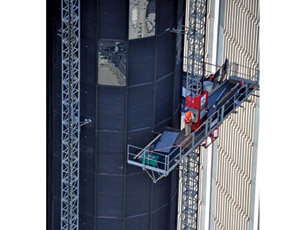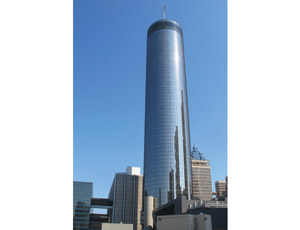With the 6,350th glass pane hoisted into place on Sept. 15, the only visible sign of anything having been awry at Atlanta’s 723-ft-tall Westin Peachtree Plaza Hotel—the tallest hotel in the Western Hemisphere—is the exterior hoist, set to come down by mid-November. But for more than two years, there were pockmarks on the glass-clad facade, which was hit by flying debris during a freak tornado in March 2008.


The 35-year-old hotel stayed open, minus damaged rooms, during the year-long, $22-million project. For several reasons, owner Starwood Hotels & Resorts Worldwide Inc., White Plains, N.Y., elected to install all new tinted glass—not just the 1,000-plus panels scarred, shattered or ripped out by flying debris—and to rehabilitate the entire curtain wall.
First, there were no replacements for the custom originals, which were oversized and tinted. Most panels were ¼ in. thick, 9.5 x 4.5 ft and 140 lb. The 400 panels cladding the restaurant in the tower’s top three levels were 13.5 x 5 ft and nearly 200 lb. Also, current codes mandate high-performance laminated glass, twice as thick and heavy as the originals.
Worn gaskets, weakened anchors and splice joints also needed work, says Michael Cogburn, vice president of envelope consultant Arnold & Associates Inc., Addison, Texas. Moreover, the cost of replacing only damaged panels was already more than half the cost of a full makeover.
First, the original structural engineer, then with architect-developer John Portman & Associates, verified that, with the addition of horizontal mullions for each panel, the existing curtain-wall system could handle the added weight of the new glass. Then, the Atlanta office of the job’s general contractor, Skanska USA, spent six months working with glass supplier Harmon Inc., Lithia Springs, Ga., to map the logistics of moving the panels, from the loading dock to the installation point, while minimizing hotel disruptions.
That was the critical path, says Graeme Kelly, Skanska’s project manager. “By observing how the glass manufacturer operated, we found that limiting the handling and movement of the panels maximized efficiency and safety, “ he says.
With the hotel’s two freight elevators not able to be used due to their limited size and a complicated access route from the loading dock, Skanska worked with hoist supplier Alimak Hek to craft a custom system that would not only deliver the panels directly to their installation destination but also position them precisely for installation. The system consisted of dual hoist platforms that allowed panels to be unloaded directly onto the lifts from shipping crates and raised to the 16th floor. From there, crews transferred panels to a second set of hoist platforms for delivery to higher levels.
Though Harmon’s crews would install most of the panels from inside the rooms, a circle of 6-ft-wide swing-stage platforms on the exterior provided elbow room for maneuvering the panels into position as well as for completing other repairs.
In addition, three custom-made, curved mast-climbing work platforms will be used to support workers as they transport and replace the panels on the circumference of the exterior elevator shaft.
Work started at the top, with windows for the rotating restaurant. Crews first applied a heavy-duty adhesive vinyl sheet to each existing pane to prevent shattering upon removal. After installing an aluminum horizontal mullion, workers placed the new glass and interior trim metal.
Some 25 panels were replaced each day. Each floor took about a week.
Old panels came down using the same system. Starwood estimates it recycled more than 600 tons of glass.
During work, a weather station and hand-held anemometers kept crews abreast of wind conditions. Work stopped when gusts exceeded 25 mph.
For safety, Skanska coordinated its approach with the U.S. Occupational Health and Safety Administration and the Georgia Tech Research Institute. There were no injuries during the job, which concluded three months ahead of schedule.
“There’s no manual for doing a job like this,” says Al Gogolin, Skanska’s senior vice president.



Post a comment to this article
Report Abusive Comment